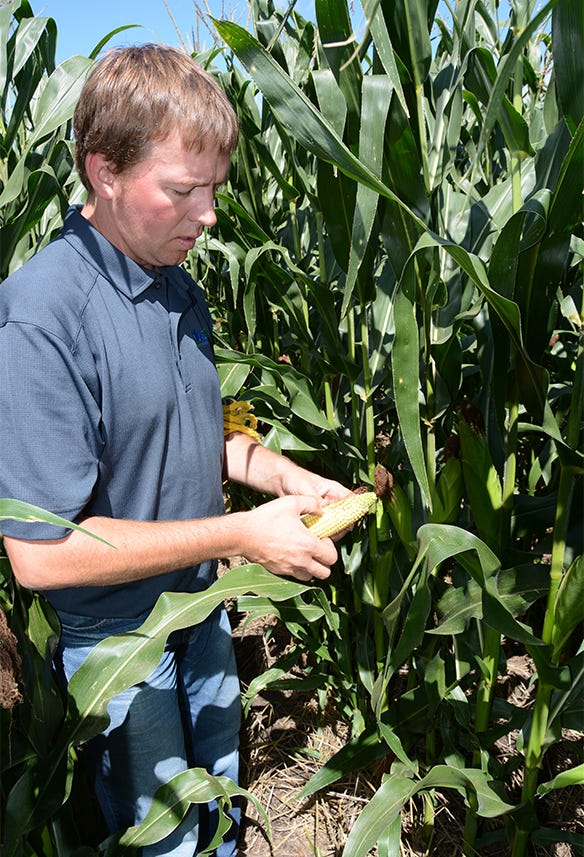June 15, 2017

Jeremy Wilson pulls his pickup into an approach to a cornfield, jumps out and plunges into the head-high corn.
He has his cellphone and a yellow plastic rope in his hands. He quickly pushes through the headland and hikes down a row. Suddenly, he stops, kneels down between the rows and plunges the pole barn nail tied to one end of the yellow rope into the ground next to a corn plant. Then he stretches out of the rope down the row, pulls it tight and pushes the nail tied to the other end of the rope into the ground.
“There. That’s one-thousandth of an acre,” he says.
Wilson is all set to estimate how much the corn might yield. The yellow rope is 17 feet, 5 inches long. His phone has a yield estimator app on it called YieldCheck.
Wilson starts counting the number of full ears that are growing along the length of the rope. Then he pulls off five or six ears at random along the rope and counts the number of rows per ear and the number of kernels per row and comes up with an average number of kernels on an ear. He punches both numbers — the ear count and kernel count — into the app, and boom, there it is: The estimated yield is 154 bushels per acre.

HOT COUNT: Jeremy Wilson counts kernels on an ear of corn.

“I do this a lot in August,” says Wilson, of Jamestown, N.D. “Estimating yields helps me get an idea of what I’ve got. The crop still has a long way to go until it is in the bin, but I can start planning.”
3 steps
Joel Ransom, North Dakota State University Extension agronomist, says that once pollination is finished, corn yields can be estimated fairly accurately. You don’t need an app, though. It only takes three steps to do it manually:
• Determine the number of ears per acre. To do this, count the number of ears that will likely produce an ear at harvest within the length of a row that represents one-thousandth of an acre (17 feet, 5 inches for corn in 30-inch rows or 23 feet, 9 inches for corn in 22-inch rows). Only count the ears that will likely contribute to yield at harvest. Don’t count late silking ears on plants that are small and scraggly or ears on tillers. In situations where there are multiple ears on a single plant, don’t count the second and third ears unless you think they are going to make a significant contribution to the overall yield.
• Count the number of kernels on at least five randomly selected ears in the length of row that you used to determine the ear number. You can multiply the number of rows and the number of kernels per row to quickly get the number of kernels per ear. Omit the bottommost kernels and any kernels that did not get fertilized in the tip of the ear. Average the kernel count.
• Multiply the number of ears times the average number of kernels per ear and divide by a kernel weight factor. From trials conducted at NDSU, Ransom suggests a kernel weight divisor of 90. Use a lower number if the hybrid produces large kernels or if you predict growing conditions will be exceptionally good during grain-fill.
Example
Within a 17-foot, 5-inch length (assuming a 30-inch row spacing) you count 30 ears and the five ears you select have 400, 350, 375, 290 and 380 kernels. The average is 359 kernels per ear. The estimated yield would be (30 x 359)/90 = 120 bushels per acre.
“It is just an estimate,” Ransom cautions. “Check it with your yield monitor and grain cart scales to confirm its usefulness in the future.”
Also, be aware that it is very hard to capture a whole field’s variability. The more places you count ears and kernels, the better the estimate will be.
You May Also Like




